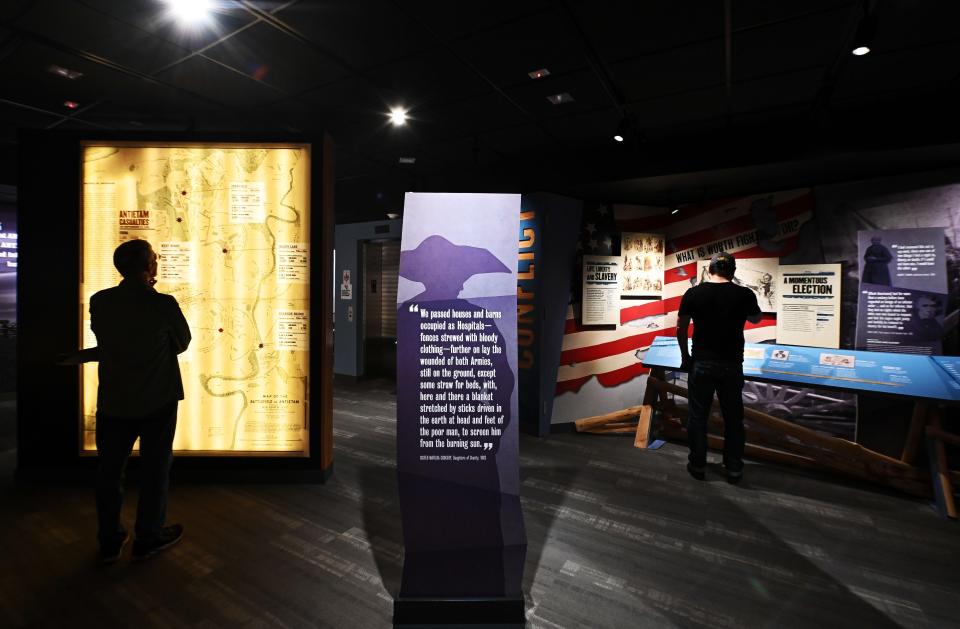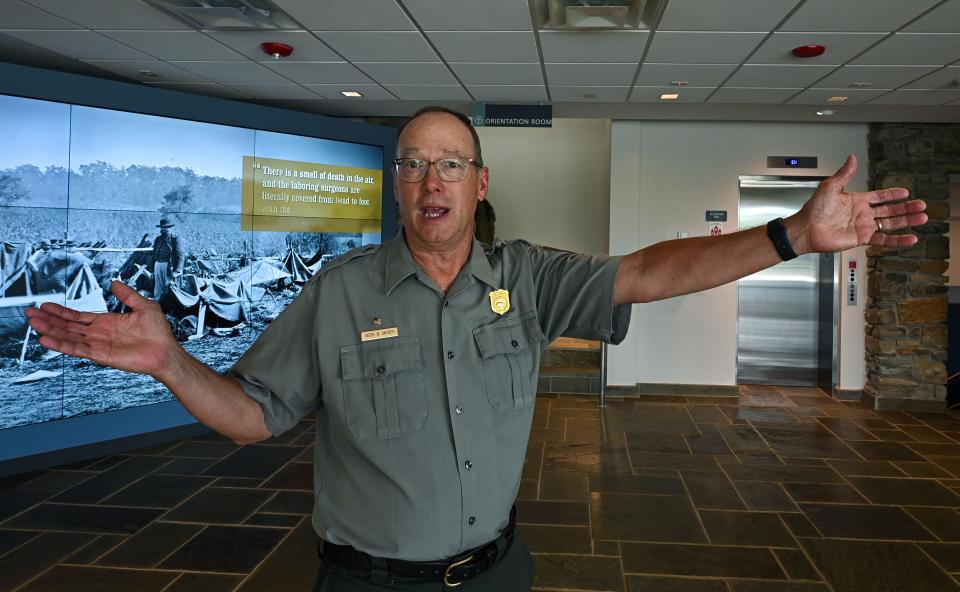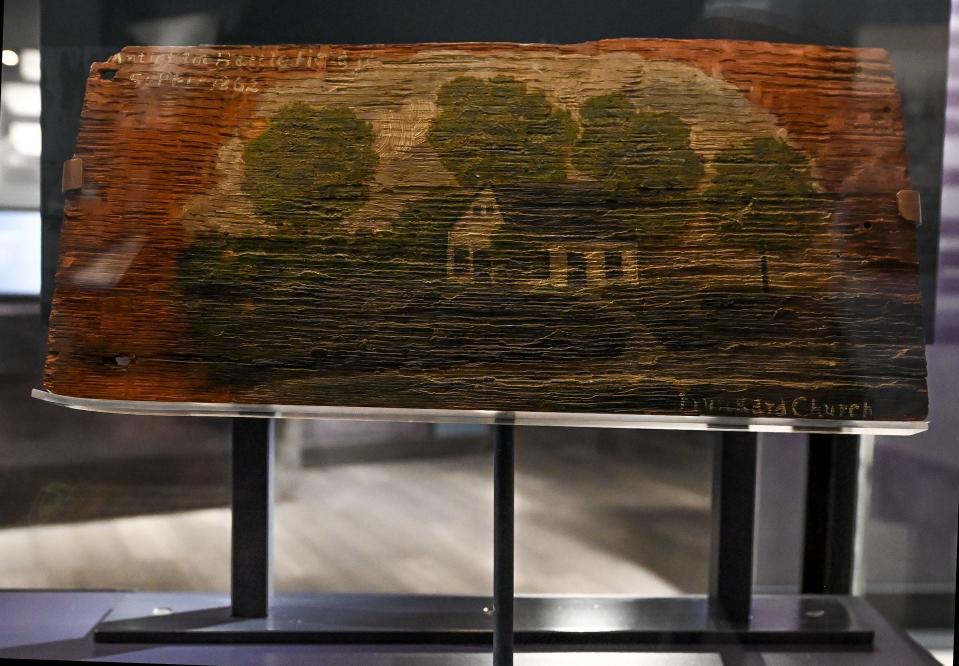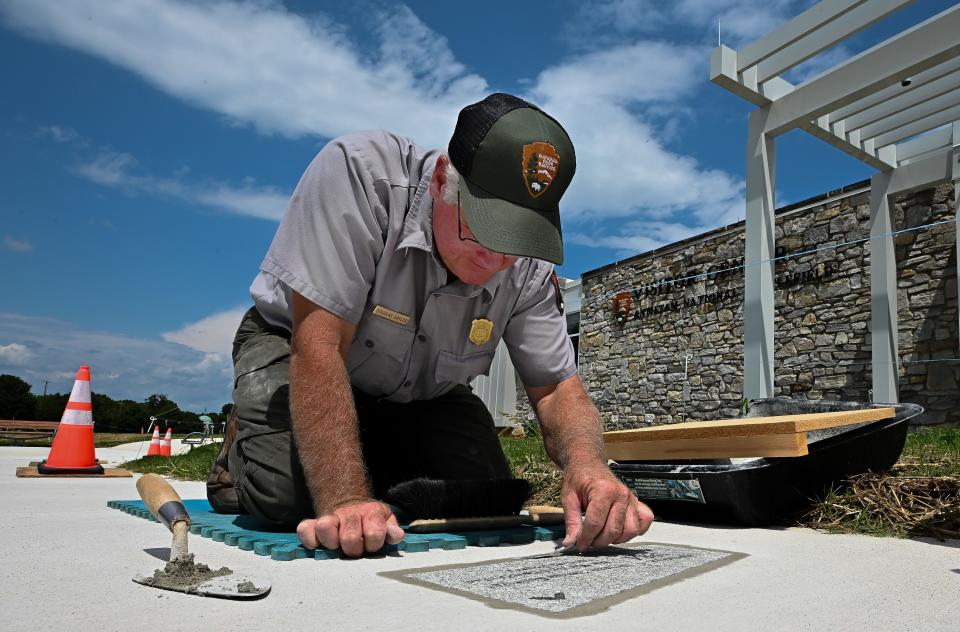Reopened Antietam visitor center to show 'causes … consequences of the American Civil War'
For the National Park Service team responsible for planning the updates to the recently reopened visitor center at Antietam National Battlefield, the shutdown of operations during the pandemic proved to be a blessing in disguise.
“The interpretive staff who did most of the research and writing and recommendations, we had much more time than we would have, because normally we’re focused on day-to-day operations,” said Keith Snyder, a park ranger and program manager at the battlefield. “The fact that we were not doing day-to-day operations, for a few months at least, so we could focus 100% of our time on research and writing — that never happens. In that sense, COVID was a huge part of the success.”
In addition to installing state-of-the-art museum cases to display a wide array of Civil War artifacts, the staff added interpretive panels featuring the latest historical scholarship to “provide more information on the causes and the consequences of the American Civil War,” Snyder said. The panels include new interactive elements, such as audio/visual experiences and tactile aspects, such as brail.

The new exhibits are particularly focused on telling the story of the Maryland Campaign, Gen. Robert E. Lee’s first invasion of Union territory, which was ultimately repelled at the Battle of Antietam on Sept. 17, 1862. The battle would be remembered as the single bloodiest day of combat in U.S. military history, resulting in nearly 23,000 casualties.
Snyder said the exhibits are arranged around five “universal concepts” that serve as narrative devices for telling the history: conflict, terror, survival, freedom and memory.
“The whole point of the exhibit is to provide information for the broadest possible audience,” he said. “That’s why we decided to use concepts that were universal, to be broader. Everyone has conflict in their life. Freedom is a universal concept, and these concepts are all directly related to the battle and the Maryland Campaign.”

How did Americans reach the point of battling each other?
The conflict exhibit, he explained, tells the story not only of Civil War battles, but of the rising tensions between North and South in the years leading up to the war, especially the events surrounding John Brown’s 1859 raid of the federal armory at Harpers Ferry.
“The primary emphasis of that area of the exhibit is to try to explain — which we did not do much of before — why there were 100,000 soldiers here trying to kill each other,” Snyder said.
Many of the artifacts on display in the exhibit were recently loaned or donated by private collectors. Steve Recker, an amateur historian who loaned the visitor center six items from a personal collection of Civil War artifacts he has been amassing for over 25 years, is also the collections manager of the Boonsborough Museum of History.
His favorite piece currently on display among the center’s exhibits is a walking stick that belonged to Samuel Cole Wright, a sergeant in the 29th Regiment Massachusetts Volunteer Infantry who was awarded the Medal of Honor for tearing down a fence impeding his brigade while under heavy fire during the battle. The area where the fence stood came to be known as “Bloody Lane” because of the number of men who were killed there. Wright was shot in his left knee after completing his mission.
“According to (Wright), 76 volunteers went forward, and six came back,” Recker said. “He was one of the six.”
Wright took a piece of that fence, removed the bullets from the wood, shaped the wood into a cane, put the bullets into the cane encased in gold, and signed it with his name and Masonic tag.
Recker said the walking stick remained in Wright’s family until Recker convinced a descendent to sell him the treasured artifact. The family member was reluctant to part with it, but Recker assured him the best chance for reuniting the cane with Wright’s Medal of Honor held at the visitor center was to allow Recker to take ownership of it.
“I made that claim 10 years ago, and so when I got it into the museum, it was like, ‘Great! Now I feel good about it,'” Recker said.
“After 150 years, it makes its way into the museum and makes its way back (to the battlefield). When you think of how many things could have kept that from happening, it’s just mind-numbing, so to be part of that is really exciting. I can’t think of where else it could go that would be better.”

The 'really cool' Dunker Church artifact on display
Snyder said one of his favorite items in the whole exhibit is a painted shingle from the Dunker Church, a building that served as a medical aid station in the wake of the battle. It became a common practice for relic-hunters to take pieces of the building, including bricks from its walls. It collapsed in a storm in 1921 and was eventually rebuilt on its foundation by the National Park Service in 1962, using as many of the original materials as possible.
Recker, who loaned the shingle to the exhibit, said when the original roof came off the church in the 1890s, the pieces were acquired by Helen Mumma, whose family originally owned the land where the Dunker Church was built and whose neighboring farm was burned during the Battle of Antietam. She painted depictions of the church on its roof shingles and sold them to veterans as souvenirs.
“This single thing is really, really cool because it was there on the day of the battle,” Recker said.
The four other items he loaned to the visitor will be displayed in the future as rotating exhibits. They include a brick from the Dunker Church, a cap pouch recovered from the battlefield, a corn cob from the battle, and another piece of fence wood that belonged to Wright.
Recker said he is particularly drawn to the cap pouch because it bears a tag indicating it was given to a Sharpsburg boy named Evans Myers, who was born about 10 years after the battle. He thinks it was a gift from either the boy’s grandfather or from O.T. Reilly, one of the first collectors of Antietam memorabilia, in order to pass on an interest in history.
“For me, there was a connection because of trying to get my son interested in history,” Recker said.

Learn about Civil War photography during a special program
The exhibit space was far from the only part of the building to be updated. Dating back to 1963, the building had some serious maintenance problems, including a leaky roof and periodic raw sewage overflows in the lobby.
In addition to repairing those issues, the renovation project included a new elevator to increase accessibility to the center’s orientation room, which allows visitors to see a sweeping view of the battlefield.
The center’s movie theater was updated with the latest projection and audio equipment, partly in anticipation of a new 25-minute park orientation movie being recorded in 4K ultra-high definition. Snyder said the new video will likely be finished by the end of the year and will provide a “sensory experience” of Civil War combat.
“The one thing about the new exhibit, a lot of it is photographs and artifacts; they don’t provide the sensory (experience),” he said. “Combat is confusing and loud, and the only way to get that is through film.”
The visitor center’s opening on Aug. 2 — the first time the building has been open since the pandemic shutdown of March 2020 — was considered a soft opening. This weekend, the visitor center will host a special program on Civil War photography in its theater.
If you goThe park and visitor center at 5831 Dunker Church Road near Sharpsburg is open every day from 9 a.m. to 5 p.m. It is closed on Thanksgiving, Dec. 25 and Jan. 1. For more information about visiting the park, go to www.nps.gov/anti/index.htm.
This article originally appeared on The Herald-Mail: Antietam National Battlefield Visitor Center reopens after renovation

